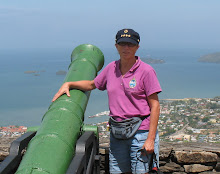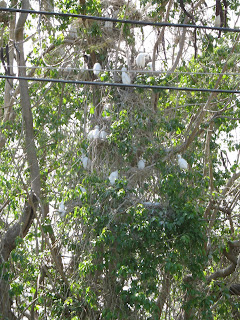Preamble
It is rather hard to find wifi connections out here in the wilderness. Thus, I dump a load of bloggage whenever I find same. That’s my explanation and I’m sticking to it.
***********************
In reviewing my last few posts, I realize I was pretty peremptory about our water woes. I will enlarge.
On arrival in Ponce, after two weeks away from Django, we discovered the head (both room and throne) full of water. Before leaving, WW had switched off the sea cock to the head (the throne), then switched off the shower/bilge pump. Unfortunately, he hadn’t realized that the handle had stopped when it bumped into the floor and needed to be taken off, reattached, and pushed further. The shower/bilge pump sits in a box into which the shower water drains. The whole head (room) is the shower stall, with a drain in the floor (or sole, as we nautical types call them). The box had, of course, filled up and overflowed into the bilge. All sorts of interesting things got soaked. Which was fine since it was mostly stuff that had come with Django and that WW hadn’t had time to sort through. Much of it was rubbish and the bilge is now a less crowded, not to mention drier place.
Immediately after repairing that minor mess, WW discovered our water pump had packed it in. Perhaps I should explain how water on a boat works. We have a couple of big steel tanks in the bow that we fill with fresh water. We also have a water maker, but it isn’t hooked up. There is a little foot-operated pump at the kitchen sink that brings in sea water, but we’ve switched that off. Salt water is horrible stuff to have inside, corrodes everything, and many cruisers refuse to have it aboard. We’ve joined that philosophical set. The water pump brings water from whichever tank has been selected. This water goes to the kitchen, the head (sink and shower) and the outside shower (for rinsing off after swims and kayaks and so on). This pump was failing to work.
Of course, repairing it would involve hanging head down in a small storage area. That goes without saying. This was, however, in a particularly obnoxious location. Underneath the seats in the salon are little cubicles. Beneath the long bench, running the width of the salon behind the salon table, are two such spaces, separated by a partition. The port one contains our four batteries and their maintenance materials—a red plastic box holding a plastic water cup and distilled water. The starboard one contains our water pump and the doodad for switching between water tanks. So WW had to remove all the cushions, crawl under the table, and contort himself up, over, and down. I helped by bringing him stuff so he didn’t have to insert and extract himself too often.

The joys of DIY pump repairs
I will not go into too much detail. The pump is affixed to a bracket which is affixed to the partition. Unable to remove the pump from the bracket, the next plan was to remove the bracket from the mitoyen wall. This meant going into the battery area and removing the nuts from the bracket’s bolts. This meant removing the (well-jammed-in) red box and contents, and shifting the batteries the small distance they would move away from the wall. It also meant discovering WW’s hands were too big.
Enter the last mate! (Did I mention I was promoted?) I too inserted myself under the table. With instructions like “don’t drop the nuts…we’ll never get them back”, it was a tension-filled few minutes for me. Plink, plank, plunk, out came all three. I was congratulated. While WW detached the bracket and removed it and the pump to the cockpit, I established for myself that I could, in fact, reach the bottom of the compartment behind the batteries, should the need ever arise.
Next we cleaned all the bits of the pump, WW put it back together and reinstalled it. This involved my putting on the nuts on the battery side of things. It wasn’t easy, but we got the dratted thing in and…it ran! And ran and ran. WW thought maybe the wee pressure tank wasn’t holding pressure. Eventually, however, the pump pulled itself together and stopped running. Regardless, we weren’t too happy with the result and decided to see if we could find a replacement.
Amazingly, at the chandlery not far from our dock, WW located a new pump. I was shopping in the Puerto Rican equivalent of Costco; stocked up on canned milk and mayo and other necessities. WW found the wine and rum in the back. Looked like we could sail straight to Panama by the time we were done.
To install the new pump, we did all the same things described above with a few small exceptions. The red box didn’t have to come out. My delicate little hands were of infinite use (especially when the TCM dropped the only 8 mm spanner behind the batteries). The new pump worked lovely. And, after we’d put back all the cushions and pillows, I remembered that the table was adjustable and could have been raised several feet up.
Next time.





















